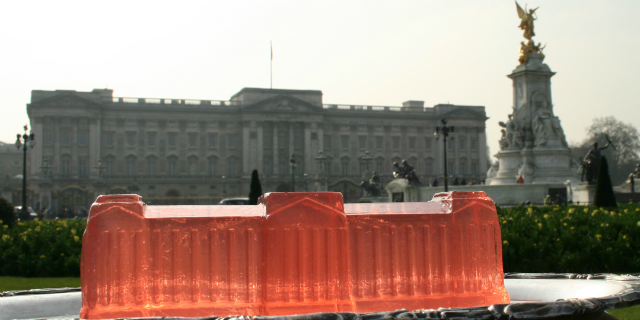Bompas and Parr’s website tells you that their company are “the leading expert in multi-sensory experience design.” A key component of these multi-sensory experiences involves the taste-buds, and their Bermondsey studios are centred on a large kitchen. I met Sam Bompas in a room dominated by what looks like a large church organ. That, says Sam, is a “flavour conductor”. It provides a novel means of appreciating whisky, and is so big that the studios had to be built round it. As Sam describes Bompas and Parr’s work over the past decade, the eagerness of his delivery complementing an exuberant fashion style, today involving a shirt covered in drawings of oysters, the impression that comes most strongly to mind is that of a latter-day Willy Wonka.
An installation in Bristol in 2012 involved setting the SS Great Britain in 55,000 litres of lime green jelly – the flavour a reference to the daily lime ration provided to sailors. In Borough Market, a project called Alcoholic Architecture involved a walk-in cloud of alcoholic cocktail, combined with more conventionally imbibed offerings from the bar. Though in homage to Southwark Cathedral next door the latter was restricted to drinks created by monks – from Benedictine to Chartreuse. And they joined the fun at the London New Years’ eve fireworks display at the dawn of 2014, contributing a multi-sensory dimension to the proceedings through edible banana confetti and bubbles filled with orange-flavoured smoke.
Bompas and Parr have promoted their cutting-edge culinary design internationally, including through the Tongue Town exhibition at the MAM museum in Sao Paulo, and work with the GREAT Campaign.
And they have big ambitions to develop a British Museum of Food, to be devoted to all aspects of food, including its history, science and art. One of the planned collections of the nascent museum is a British Menu Archive, which will aim to document changing tastes through the medium of menus. In typical fashion they are pursuing this by teaming up with 2015 Turner Prize winners Assemble to collect menus using a specially commissioned tour bus.
They are also promoting the museum through a series of temporary exhibitions. I headed to one of a pair of gasometers north of Kings Cross station, trendily restored as upmarket apartment living, to view “Scoop: A Wonderful Ice Cream World.” An exhibition devoted to ice cream. This is centred around the extensive collection of all things ice cream of Robin and Caroline Weir, and Robin welcomes you in with a video, exuding his passion for the stuff.
You enter a suitably chilly ice chamber, and then a more conventional but fascinating exhibition space, where you learn about penny licks, the little glasses from which ice cream was served in the late 19th century. Their reuse was linked to the spread of disease, and so at the start of the 20th century they made way for the wafer cones we know today.
The exhibition has a star, Agnes Bertha Marshall, who wrote books with names like “Fancy Ices” and earned herself the nickname “the Queen of Ices” for her work in popularising ice cream in Victorian society. She was far ahead of her time, even suggesting the use of liquid nitrogen to make ice cream, and died at the age of 49 following a fall from a horse. At “Marshall’s School of Cookery” in the exhibition you can make your own ice cream, which mostly seems to involve vigorously shaking a plastic pot filled with the requisite ingredients.
A mysterious canopy, with “18+” warnings, turns out to conceal a documentary on the 1980s Glasgow Ice Cream wars, when drugs were sold from ice-cream vans. And more cheerfully there is a display of large lolly sticks bearing jokes such as:
“How did Reese eat her ice cream?”
“Witherspoon.”
You can try glow in the dark ice cream, and experience “moo-phoria”, which shows the effect of eating ice cream on the brain waves (it sends them all into a tizzy, basically). There is a rather sad statistic that less than one per cent of the vanilla flavour in ice cream these days comes from vanilla flowers: most is from the synthetically made vanillin. Apparently production in Madagascar is unable to keep up with demand, compounded by the devastation wrought by Cyclone Enawo in 2017.
There are quotes around the place about the importance of ice cream. This from Ralph Waldo Emerson: “We dare not trust our wit for making our house pleasant to our friend, so we buy ice cream.” Diplomatic entertaining in a nutshell. And this from Snoop Dogg: “When I’m no longer rapping, I want to open up an ice-cream parlour and call myself Scoop Dogg.”
Emerging out of the exhibition, you can try a scoop at the shop, Conehenge. The flavours are predictably wacky, like the marmalade on toast all day breakfast ice. Which tasted impressively marmalade-on-toasty. Which is as it should be: great culinary design has to taste good too.

